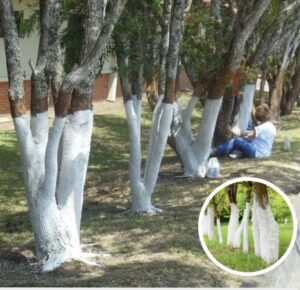Why You Sometimes See Tree Trunks Painted White

If you’ve ever wandered through an orchard, along a country road, or even in someone’s backyard and noticed tree trunks coated in white paint, you might have wondered: what’s going on here? It may look unusual, but there’s a very practical reason behind this tradition.
Tree Markings and Their Meanings
Different paint colors on trees often carry specific messages. For example:
-
Orange spots usually mean the tree is marked for removal.
-
Purple paint is commonly used in the U.S. to mark private property boundaries and to warn trespassers.
-
White paint, however, serves a completely different purpose—it’s all about protection.
Why Paint Trees White?
The main reason is to prevent a condition called sunscald. During winter, trees can experience extreme temperature swings—frigid nights followed by warm, sunny days. This sudden change can cause the bark to expand and contract too quickly, leading to cracks or splits that weaken the tree over time.
By painting the lower part of the trunk with a light, reflective color like white, heat absorption is reduced. This helps stabilize the bark’s temperature, keeping it safe from damage.
The Right Way to Do It
Not just any paint will do. Water-based latex paint is the go-to choice for gardeners and orchard keepers. Typically, it’s diluted with an equal part of water to make it less harsh on the tree. Some even mix in joint compound, which can create an added barrier against insects that like to bore into the bark.
Application matters, too. A paintbrush is preferred over spraying, since it creates a more even, protective coat. For most trees, this process is repeated once a year, almost like giving the tree its very own winter jacket.
More Than Just Looks
While the sight of rows of neatly painted trees might look decorative, the tradition is rooted in function, not fashion. It’s a simple, time-tested practice that helps extend the life of young or vulnerable trees, particularly fruit trees or ornamental ones exposed to harsh seasonal changes.
In short, that splash of white on a tree trunk isn’t random—it’s a clever shield, carefully applied by those who know that a little bit of paint today can protect a tree for many years to come.